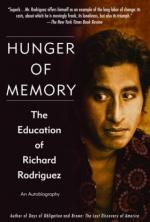
|
| Name: _________________________ | Period: ___________________ |
This test consists of 15 multiple choice questions and 5 short answer questions.
Multiple Choice Questions
1. How does Rodriguez describe the 1960s student?
(a) Prone to protesting, but with good intentions.
(b) A troublemaker.
(c) Too politically liberal.
(d) Idealistic and admirable.
2. In the last chapters of the book, what is Rodriguez keeping secret from his family?
(a) That he's writing a book.
(b) That he wants to be a construction worker.
(c) That he dropped out of school.
(d) That he no longer goes to church.
3. In Complexion, Chapter 3, what new hobby does Rodriguez take up?
(a) Skiing.
(b) Long-distance running.
(c) Skateboarding.
(d) Scuba diving.
4. What is the Third World Student Movement?
(a) Students who come from third world countries to attend school in the United States.
(b) Students who are studying third world countries in college.
(c) Students who attend college but embrace their cultural heritage instead of sacrificing it.
(d) Students who volunteer in third world countries.
5. In Credo, Chapter 3, what does Rodriguez do to change his ideas about religion?
(a) He studies theology.
(b) He travels to other countries.
(c) He studies to be a priest.
(d) He visits a lot of different churches.
6. What example does Rodriguez offer of how affirmative action can have negative consequences?
(a) Students who flunked out of college.
(b) His own experience as a minority who struggled in college.
(c) Students he knew in graduate school who had never written a paper.
(d) Students who were helped by affirmative action, but then did not help their fellow minorities.
7. How does Rodriguez's sister's friend challenge his ideas about complexion?
(a) She is white, but not rich.
(b) She is black, but not poor.
(c) She is dark-skinned but spends more time indoors than he does.
(d) She is light-skinned but spends more time outdoors than he does.
8. Who teaches Rodriguez that stereotypes are not accurate?
(a) His boss at his job.
(b) His professors at Stanford.
(c) The well-educated construction workers.
(d) The other students.
9. Because of his skin color, what did Rodriguez's parents worry about?
(a) That he would have a harder time in school.
(b) That he would get involved with a gang.
(c) That people would discriminate against him.
(d) That he would take a hard labor job.
10. What changes Rodriguez's ideas about his complexion?
(a) He writes a news story about the "Black is Beautiful" movement.
(b) He works construction and gets comfortable about revealing his skin.
(c) He talks about it with one of his professors.
(d) He talks about it with other minority students.
11. Why does Rodriguez's mother not understand his explanation about psychiatry?
(a) Because she has a cultural attitude about private life and public life.
(b) Because he does not tell her the truth.
(c) Because he is explaining in English.
(d) Because she has a cultural attitude about writers.
12. When a student complains that he is being kept out of law school, what does Rodriguez do?
(a) Tell him to stop whining.
(b) Stay out of it.
(c) Support his case.
(d) Argue against his case.
13. What does Rodriguez think skin color says about financial status?
(a) Dark-skinned people are rich.
(b) Dark-skinned people are poor.
(c) Light-skinned people need to work less and get outside more.
(d) Light-skinned people are poor.
14. Now that he is a teacher, what does Rodriguez blame white students for?
(a) They are arrogant and selfish about their grades.
(b) They do not make an effort to help poor white students get an education.
(c) They are rude to the minority students.
(d) They think they are smarter than the professors.
15. What has happened to Rodriguez's classmate who applied for the same type of teaching jobs?
(a) He is told the schools will not hire a minority candidate.
(b) He gets one or two offers from out-of-state schools.
(c) He does not get any job offers.
(d) He gets lots of good job offers.
Short Answer Questions
1. What does Rodriguez have to face in order to write the book?
2. While he writes his book, how does Rodriguez support himself?
3. When he was a child, what did his parents say he looked like?
4. What example does Rodriguez offer of a program that can help minority students?
5. In Complexion, Chapter 3, what does Rodriguez realize about education?
|
This section contains 747 words (approx. 3 pages at 300 words per page) |

|




